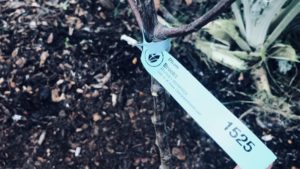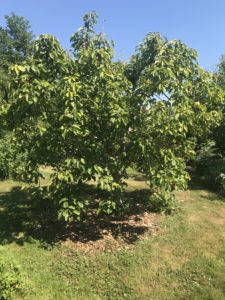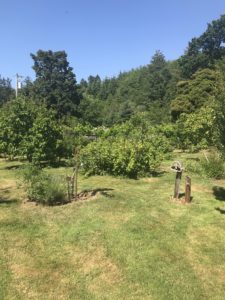Planting Fruit Trees for a Backyard Orchard
Planting fruit trees for an urban homestead orchard is rewarding. A fruit tree takes several years to begin bearing fruit. However, once established it provides an abundance of delicious food year after year. As a result, it is wise to take the time to plan where to plant fruit trees in order for them to achieve their potential. After all, if you select a collection of fruit varieties it is possible to grow and preserve fruit to enjoy all year long.
Just like gardening, backyard orchards have many different styles and techniques to explore. You will want to think about the design of your space and have much to consider. The variables are endless from different fruit trees, rootstocks, varieties, and pruning methods.

The following overview provides a glimpse into what you need to know to plant a fruit tree and manage an urban orchard.
Planting Tree Basics
When planting a fruit tree there are a few key principles to keep in mind to increase success. First, select fruit trees that you enjoy eating. Second, think about the planting location before you dig so it goes in an acceptable spot. Third, dig a deep and wide hole with a shovel to allow the roots to flourish. Fourth, amend the soil if the native ground is poor soil. Fifth, water the tree very well and continue to water slowly and deeply at least once per week for the first year or two. Lastly, mulch fruit trees with wood chips to feed the soil and grow the mycelium supporting the tree. Planting a fruit tree is a straightforward project, but in case you have questions you can quickly learn how to plant a fruit tree.
Types of rootstocks
The rootstock that a fruit tree has will determine the size, vigor, and potential disease resistance of the tree. When you purchase a fruit tree from a nursery the rootstock will be listed along with the variety. Different fruits such as apples, pears, and cherries, have different names for rootstocks. In general, the rootstock will correspond to a size description such as dwarf, semi-dwarf, and standard. This corresponds to how large a fruit tree will grow and to some extent the vigor or lack thereof in the tree.
Backyard orchardists can benefit from selecting rootstocks that limit the overall growth and vigor of the trees that they plant. By utilizing dwarf and semi-dwarf rootstocks and aggressive pruning techniques it is possible to keep trees small and easily manageable. Take the time to learn about the different rootstocks prior to purchasing fruit trees. This education ensures making the right selection for the urban homestead you envision.
Types of Trees
Depending on the climate that you live in there may be a narrow or wide array of trees that you can plant. It is important to understand what zones a tree can grow and bear fruit in. Some trees require a certain number of chill hours, meaning they require cold winters in order to bear fruit the following year. On the other hand, some trees such as citrus and tropical fruits are not very cold-tolerant. These may perish when planted where the ground may freeze or experience air temperatures below freezing.
Learn about the fruit trees that grow best in your region. It is possible to utilize certain growing techniques to push the zones that you can successfully grow in. As a result, a person growing in zone 8 can sometimes grow fruit trees that technically require zone 9 or 10. However, this requires a lot of planning and still comes with the potential for failure down the road due to an unforeseen cold snap in the weather.
Urban homesteads generally are limited in space, so select fruit trees that will work year after year. Pick trees that you love and will enjoy preserving to enjoy the harvest all year long.
Tree Pruning Basics
There are several ways to prune a fruit tree. Pruning a fruit tree requires you to choose a style and stick with it. The two most popular methods for managing a fruit tree are the single leader method and the open center vase method. The single leader is designed around growing a single main branch vertically and selecting strong horizontal branches to keep. The open center vase method is designed around 3-5 main branches. The tree is pruned at around 12 – 24 inches above the ground when planted. Then branches are selected to keep and trained to the outside leaving the middle open for air and sunshine.
Pruning fruit trees is best done during the dormant season of winter. While a tree is dormant it is possible to prune as much as ⅓ of the branches in a single season. However, that aggressive pruning may cause the tree to send up a lot of suckers. Summer pruning can be a viable method to lower a tree’s height. In addition, it reduces the overall vigor keeping the tree small and compact.
The first 3 years are the most important years to prune as this is when a tree’s shape is determined. As a result, if the tree is pruned well during this time it will have the foundation to grow into a very beautiful, productive fruit tree.

Grow a Big Tree, Medium Tree, or Small Tree
Determine what kind of backyard orchard you desire. Some people enjoy a couple of very large fruit trees and plan to enjoy hanging out under the shade the tree provides. Other people want small fruit trees so they can pack as many different types and varieties of trees onto their urban property. Ultimately, the choice is up to you, however, it is wise to envision what you want your property to look like in 10 years and plant the correct rootstocks and number of trees to achieve your dream.
Backyard Orchard Culture
It is possible to grow 30 or 40 fruit trees on a small property in an urban setting. This is contrary to the beliefs of many people. Backyard orchard culture is a relatively new phenomenon in urban homesteading. The ability to keep fruit trees small through rootstock selection and aggressive pruning means you can densely plant fruit trees. As a matter of fact, if you want a hedge of citrus trees or apple trees it is very possible to manage the trees to achieve this.
While one tree one hole seems the only logical way to plant a fruit tree, there are successful strategies from planting two trees or even three trees in the same hole. Through proper pruning, it is possible to plant trees as close as five feet apart when the common rule of thumb is the closest a tree should be planted to another is fifteen feet or more.
Fruit tree guilds
What is a fruit tree guild? Simply, a tree guild is a series of plants that support one another and serve different functions in the environment. As an example, a fruit tree is often the centerpiece in a plant guild. This fruit tree will then have several shrubs around the tree such as blueberry, raspberry, currents, etc. Furthermore in the space between the trees and shrubs flowers, herbs, and ground cover plants will be added. These may include plants such as tulips, bee balm, yarrow, comfrey, thyme, rosemary, garlic, and more. Use wood chips from the chicken run to feed the plants rich material the soil organisms love.
Each plant in the guild occupies its own niche. Depending on the plant some assist by resisting the browse from local deer or increasing the visitation of bees and other pollinators. A fruit tree guild is a common concept in permaculture. Consequently, it is a technique that can prove very successful in an urban homestead design.
The best time to plant a fruit tree was twenty years ago, but the second-best time to plant a fruit tree is today. That is a popular saying in the fruit tree growing community and it couldn’t be more true. Fruit trees provide so many benefits to an urban homestead. Have fun selecting the specimens you want to grow and enjoy the reward of eating delicious tree-ripened fruit.

Watering Fruit Trees
Watering fruit trees is important to the long-term growth of your food forest. Trees need to be watered frequently when they are initially planted. Young trees need to have moist soil to extend their roots into to establish themselves.
As trees mature less frequent watering will be required. However, do not avoid watering mature trees during the fruiting season if you live in a warm or dry location. Fruiting trees require water out to the drip line of the canopy in order to thrive. Give the trees the water that they require and you will reap the benefits in big hearty harvests.
Schedule the watering with a drip irrigation system and timer so you can be away on vacation and water the garden and food forest.




Recent Comments